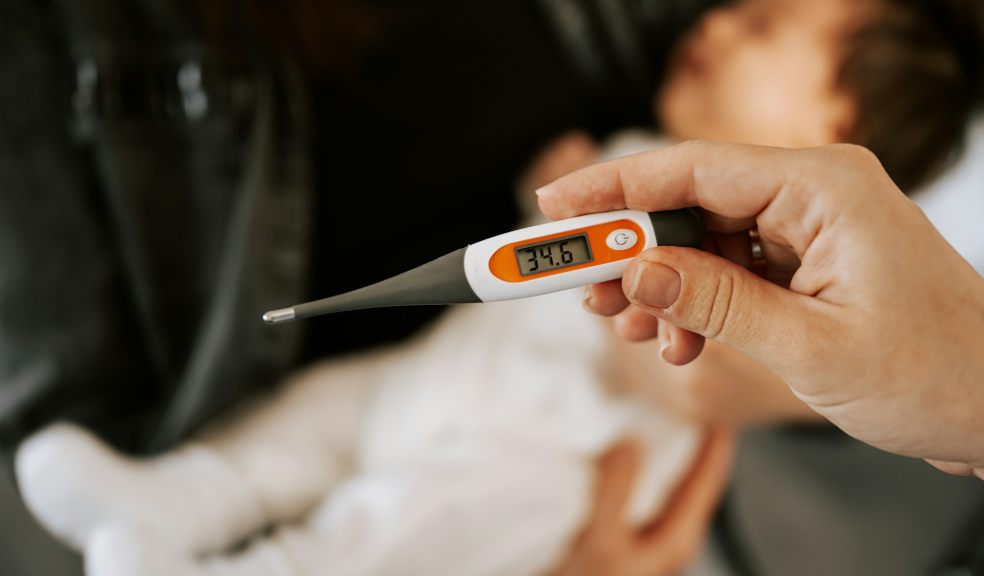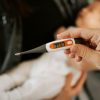
Childhood Fevers: When to Worry and to Wait
Your child's forehead feels warm. You reach for the thermometer and see the numbers climbing. Your heart starts racing as a dozen questions flood your mind. Should you rush to the emergency room? Call the doctor? Or is this just another normal part of growing up?
Every parent faces this moment. That split second when you discover your little one has a fever and suddenly feel lost between panic and uncertainty. You want to do the right thing, but figuring out what that is can feel impossible.
Luckily, this article breaks it down for you!
What Is a Fever?
A fever in children often signals that the immune system is responding to an underlying illness. It's not an illness but a symptom showing the body is fighting off an infection.
Paediatricians usually consider anything at or above 100.4°F (38°C) a fever. Normal body temperature averages around 98.6°F (37°C), although it can shift slightly throughout the day.
When a child gets sick, the brain's hypothalamus tells the body to raise its temperature. This creates an internal environment that helps slow down the growth of viruses and bacteria.
Childhood fevers are one of the most common reasons parents seek medical advice. In many cases, they're part of a healthy immune response. While the rising number on a thermometer can feel alarming, the fever often means your child's body is doing exactly what it should.
However, it's crucial to seek immediate medical attention in severe situations. If you're worried that this may be the case, look for trustworthy urgent care facilities. Research and visit various online resources to examine their paediatric care services. For instance, you can explore sites like just4kidshealth.com or others that focus on children's health for quality care and immediate response. Make sure the clinic has experienced and licensed health professionals ready to help at all times.
What Are the Common Causes of Fever in Children?
Understanding the cause behind the fever can help you respond more calmly. Some of the most common sources include the following:
- Viral infections: Colds, influenza, and respiratory illnesses can lead to mild or moderate fevers. Symptoms may include coughing, sneezing, or a runny nose, and the fever can resolve on its own with fluids and rest.
- Bacterial infections: Strep throat, pneumonia, and urinary tract infections are great examples of bacterial illnesses that can cause higher fevers. These often need medical care and may come with pain, fatigue, or difficulty breathing.
- Ear infections and sore throats: These are prevalent in younger children and can cause low to moderate fever, fussiness, trouble sleeping, or tugging at the ears.
- Teething: While controversial, some children may experience a slight fever during teething. You might notice swollen gums, extra drooling, or irritability at the same time.
- Post-vaccination response: It's normal for some children to run a low fever after receiving certain vaccines. This can last a day or two and is part of the body's immunity-building process.
- More serious illnesses: Conditions like meningitis, appendicitis, or juvenile arthritis may cause persistent or recurring fevers and often come with other symptoms such as joint pain, stiffness, or rash.
Recognising the possible cause of a child's fever can ease worry and help you decide what action to take. Watch for signs like a persistent cough, vomiting, or a skin rash, as these often provide helpful clues about what your child's body is fighting.
When Is a Fever Not Dangerous?
Many childhood fevers are mild and don't point to anything serious. A low-grade fever often means your child's immune system is doing its job to fight off a minor infection. If the fever doesn't cause discomfort and goes down with rest, fluids, or age-appropriate medication, there may be no need to worry.
If your child remains alert, continues to eat and drink, and shows interest in play, the fever may be part of a routine viral illness. In children over three months, temperatures ranging from 100.4°F to 102°F can be managed without urgent medical care.
It helps to focus more on your child's behaviour than just the temperature reading. Some kids may run a higher fever and still act relatively normal, while others with lower fevers might seem more tired or irritable. Watching for changes in energy, appetite, or sleep patterns can give a better picture of how serious the illness might be.
When to Monitor and Wait
If your child has a low-grade fever but seems alert, comfortable, and is breathing without difficulty, it's often safe to monitor the situation at home. Many paediatric fevers are linked to common viral infections that resolve with rest and hydration. During this time, offer fluids regularly and keep your child dressed in light clothing to prevent overheating.
You don't always need to reach for fever reducers right away. Fever is a natural immune system response and plays a role in fighting off infection. Still, if your child appears uncomfortable, has body aches, or can't fall asleep easily, you can give age-appropriate medication like acetaminophen or ibuprofen. Always check the correct dosage based on weight and never give aspirin to a child.
Observing your child's symptoms, responding calmly, and knowing when to wait instead of rushing to an emergency care facility is a form of good parenting. This can help reduce unnecessary stress for you and your child while allowing the body time to recover.
Track the temperature, look for new symptoms like vomiting or skin rashes, and note any differences in energy or appetite. If the fever stays below 102°F and your child continues to eat, drink, and interact with you, it's often best to wait and give their body a chance to recover naturally.
When to Worry About a Fever
While most childhood fevers may be harmless, some can point to a more serious health issue. It's vital to recognise the signs that may require immediate medical attention.
Call your doctor or seek emergency care if:
- Your baby is younger than three months and has a rectal temperature of 100.4°F or higher, even without other symptoms.
- The fever rises above 104°F at any age or doesn't respond to fever treatment.
- The fever lasts more than three days without signs of improvement, especially if your child seems to be getting worse.
Other warning signs may include:
- Extreme drowsiness, confusion, or difficulty waking your child.
- Breathing that's fast, strained, or noisy.
- Constant crying that's weak, high-pitched, or can't be comforted.
- A rash that doesn't fade when pressed or looks like bruising.
- Signs of dehydration, such as a dry mouth, sunken eyes, or few wet diapers.
- Severe headache, stiff neck, or sensitivity to light.
These symptoms could point to a severe bacterial infection, such as meningitis or sepsis, which requires immediate medical attention. Always trust your instincts. You know your child better than anyone, and getting help early can make a difference.
Understanding Febrile Seizures
For many parents, seeing a febrile fever can be one of the most frightening experiences during a childhood fever. These seizures sometimes happen in children between six months and five years old when the body temperature rises quickly due to an infection.
During a febrile seizure, your child might lose consciousness, stiffen, shake, or have unusual eye movements. Although these episodes are alarming, most may last less than five minutes and not lead to long-term complications. They often occur during the early stages of a fever, especially when the temperature climbs suddenly.
After the seizure, gently place your child on their side and check that they're breathing steadily. You should contact your doctor if this is the first seizure, if it lasts longer than five minutes, or if your child has trouble recovering afterwards. It's best to have medical professionals guide the next steps in those moments.
Febrile seizures aren't linked to epilepsy or permanent brain damage. They usually happen during common viral infections and don't mean your child has an underlying neurological condition. However, they're a sign that you should monitor fevers more closely, especially if your child has had one before.
How to Treat a Fever at Home
Treating a fever at home starts with helping your child feel at ease while supporting the body's natural immune response. In most cases, a mild to moderate fever linked to a viral infection can improve with basic care and observation.
Begin with simple steps to reduce discomfort and encourage hydration:
- Offer water, diluted juice, or oral rehydration drinks throughout the day to keep fluids up.
- Let your child rest as much as they need, though quiet play is usually fine if they're up for it.
- Choose loose-fitting clothing and use breathable blankets to help regulate body temperature.
- Maintain a cool and comfortable room, and open a window for fresh air circulation.
- A lukewarm sponge bath can help lower the temperature when your child feels overly warm.
For children who appear tired, irritable, or restless, a dose of acetaminophen or ibuprofen can help ease body aches and reduce fever. Stick to age-specific dosage guidelines and avoid giving aspirin, which isn't safe for young children. Only use one fever reducer at a time unless your healthcare provider gives different instructions.
Additionally, avoid methods like cold baths or alcohol rubs, as these can shock the body and make your child feel worse. Wrapping them in heavy blankets or layers can also trap heat and lead to chills. So, instead of chasing a perfect temperature, aim to keep your child comfortable, relaxed, and well-hydrated.
How Long Should a Fever Last?
Most viral fevers in children last two or three days. Some mild illnesses can cause the temperature to rise and fall for up to five days, especially during early childhood when the immune system is still developing. When the fever responds to fluids, rest, or medication, and your child remains active or alert, there's usually no reason to panic.
Sometimes, a fever that lingers beyond 72 hours without clear improvement should be checked. A recurring fever that returns after a brief break may point to a secondary infection or a condition that needs medical attention. If your child shows new symptoms like vomiting, rash, or extreme fatigue, it's best to contact your healthcare provider.
Tracking fever patterns can make a real difference. Write down when the fever started, how high it reached, and how your child behaved during those moments. These details can help your paediatrician determine whether the fever is part of a simple viral infection or something more complex.
Understanding Chronic or Repeated Fevers
While many childhood fevers are linked to short-term infections, some may return regularly or last longer than expected. When your child experiences frequent fever episodes or low temperatures that continue without an apparent cause, it's worth looking into the pattern more closely.
Ongoing fever in children may signal issues such as immune system concerns, repeated viral or bacterial infections, or inflammatory conditions that need monitoring. In rare cases, symptoms could be tied to periodic fever syndromes or other chronic illnesses. Recording temperature readings, duration, and other symptoms can help you track patterns that might go unnoticed.
Talk with your child's healthcare provider if you observe:
- Fever that returns on a regular cycle, such as every two to four weeks.
- Persistent low-grade fever that doesn't go away completely.
- Unexplained symptoms like weight changes, skin rashes, or joint pain.
Even when the cause turns out to be minor, these signs are worth discussing. Early attention to chronic fever patterns gives your doctor the information to decide whether further evaluation or testing is necessary.
Conclusion
Managing baby fevers can be overwhelming when they catch you off guard, especially at night or when your child seems more irritable than usual. But with the right knowledge, those moments become easier to manage.
As you care for your child, stay alert to fever patterns, trust your instincts, and don't hesitate to contact a healthcare professional when something feels off. With patience, observation, and the right support, you'll be prepared to handle childhood fevers with more confidence and peace of mind.
Key Takeaways
- Most childhood fevers are caused by viral infections and are part of a healthy immune response.
- If your child is alert, eating, drinking, and playing, a low-grade fever can usually be safely monitored at home.
- Watch for warning signs like breathing difficulty, persistent crying, high fever, rash, or seizures, which may require urgent care.
- Febrile seizures are often harmless and short-lived, but always speak to a doctor if one occurs, especially for the first time.
- Home care, such as hydration, rest, and fever-reducing medicine, can help ease discomfort and support recovery.
- Tracking fever patterns and symptoms over time can help your paediatrician identify possible underlying issues if the fever keeps returning.
- Good parenting means staying calm, observing behaviour, and knowing when it's safe to wait and when to act.

















